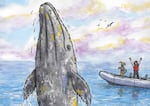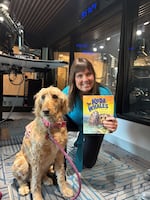
An illustration from Jack Wiens shows how excited Koda and Carrie Newell get when they see a gray whale breaching. The illustration comes from Newell's children's book 'Koda and the Whales.'
Jack Wiens
Every summer, a small group of gray whales gather along the Oregon coast to feed.
Marine biologist Carrie Newell studies the seasonal residents of Depoe Bay and has written several books about her research. The latest shares the story from a different perspective.
“Koda and the Whales” is the illustrated account of Newell’s dog Koda who learns all about the gray whales and how to help spot them.

Carrie Newell and her dog Koda came to the OPB studios in March 2025 to share some details about her new children's book 'Koda and the Whales.' The illustrated account tells the story of her research on the gray whales of Depoe Bay through the eyes of Koda as she learns to spot them.
Jess Hazel / OPB
This conversation has been edited for length and clarity
Jess Hazel: So Koda’s the second dog you trained to sniff out and react to whales, and now you’ve trained a third, Koda’s daughter, Kilo, to do the same. What inspired you to start training your dogs to do this, and what does that process look like?
Carrie Newell: Well, with Kida [Koda’s mother], when I was doing my research at Oregon State, I would take her on my boat with me. When I smelled something super stinky, which was, of course, the whale’s breath, the blow, she became so excited, so I encouraged that behavior. And, matter of fact, Kida became so good that she would put her right ear up if a whale would come from the right and her left ear up if a whale was coming from the left. She was amazing.

Carrie Newell's dogs, Kida, Koda and Kilo, have all learned how to sniff out whales to help with Newell's research on the gray whales of Depoe Bay. In the introduction to 'Koda and the Whales' Newell gives some background on her pets and how the book came to be.
Jack Wiens
Hazel: You were the first researcher to learn what the gray whales off Depoe Bay eat because you studied their poop. I feel like kids, in particular, will connect with that little detail. A little more than 200 whales gather there in the summer. Is it the shrimp that draws them or is there something else that you think makes this smaller group stop at Depoe Bay instead of heading on to Alaska?
Newell: I’m sure it’s the mysid shrimp. I made that discovery in the late late 90s. As I was looking at the gray whales, they would always say that they ate amphipods, but amphipods live in mud. And the thing is, the gray whales were in the kelp. Kelp is attached to rock.
So I got on my SCUBA gear and dove down and found these huge swarms of mysid shrimp. Then I collected the whale poo and I analyzed it and I found the actual tails of the mysid shrimp in their fecal material. I could even tell the exact species. There’s two primary species, and the mysid shrimp are in very shallow water. And gray whales are extremely good in shallow water. I’ve had gray whales who are 8 feet thick being 6 feet of water. It’s amazing.
Hazel: Marine biology and science, in general, can sometimes be a little bit dense or full of language that isn’t always accessible for younger folks. What kind of information was the most difficult to simplify?
Newell: So I have named each whale a certain name according to the pattern, their dorsal hump. My favorite is Eagle-eye. Oh my goodness, he’s amazing. If I was a gray whale, he’d be my honey. You know, he’s unique. What I want to get into the book, as far as children are concerned, is that each one of us, even the whales, are individuals. And that we need to respect everyone.
And also, what was a little more difficult [to explain], is how to deal with the loss of a pet.
I lost Kida. And it was hard. But I wanted to share the story and say, “You know, this happens.”
Hazel: Well, and I noticed in your introduction, you write about how this book is more than just interesting whale facts, but how dogs and whales can shine a light on important values like individuality and family and friendship. Can you share a specific detail that you think really illustrates that in the book?
Newell: I went out with a group of people, and we went off Whale Cove and Kida was hanging over the side, and Scarback came up to the boat over and over and over and over. Finally, I had to go back. Scarback came one last time and fluked up, put her tail fluke up, and that was the last time that Kida saw a whale.
I truly believe Scarback knew Kida was sick. I’ve seen her almost every year since 1992. She’s amazing. But when she did that encounter, it’s like, “Whoa, that was really special.”
Hazel: That’s a beautiful story. And those memories and getting to share them, I feel like, are part of that process of grief. Of getting to share those memories too.
Newell: Yes, definitely. I mean, we all deal with it in some way or another. I tried to share that but also give it a happy ending.

Marine biologist Carrie Newell wrote about her experience with the loss of her first whale-sniffing dog, Kida. The book 'Koda and the Whales' tells the story of Kida's final whale encounter.
Jack Wiens
